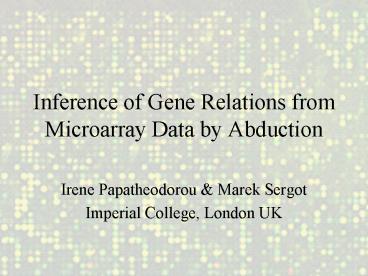Inference of Gene Relations from Microarray Data by Abduction PowerPoint PPT Presentation
1 / 26
Title: Inference of Gene Relations from Microarray Data by Abduction
1
Inference of Gene Relations from Microarray Data
by Abduction
- Irene Papatheodorou Marek Sergot
- Imperial College, London UK
2
Outline
- Gene Regulation Microarrays
- Abductive Logic Programming
- Proof Procedure
- Model of Gene Interactions
- Applications Tests
- Evaluation Further Work
3
Gene Regulation
Cell Response
Gene Regulation A B C
Gene Expression DNA/gene mRNA Protein
External Stimulus
Microarrays measure gene expression
4
Microarray Experiment
Measures levels of gene expression
A
A
B
B
Experiment gene mutation/environmental stress
5
(No Transcript)
6
Expression Data to Gene Relations
- Mycobacterium tuberculosis experiments from CMMI
- Genomic Information-Background Knowledge
- Gene Relations- inhibits/induces
- Inference Method Abduction
7
Deduction
model of howgenes work (in general)
Organism A gene X regulates gene Ygene U
inhibits gene V
observedgeneexpression
Infer the effect from rules
8
Abduction
model of howgenes work (in general)
Organism A gene X regulates gene Ygene U
inhibits gene V
observedgeneexpression
Inference from effect to cause
9
Abductive Inference
- Theory represented by (P, A, I)
- P is a logic program
- A is a set of abducible predicates-Do not occur
in head of any clause in P - I Integrity Constraints, logic rules
10
Abductive Explanation
- Given an abductive logic theory (P, A, I), an
abductive explanation for a query Q is a set ?
of ground abducible atoms on the predicates A
such that - P ? ? LP Q
- P ? ? is consistent
- P ? ? LP I.
- LP denotes some standard logical entailment
relation of logic programming
11
Kakas-Mancarella Procedure
- Extension of basic resolution used in SLD SLDNF
for ordinary logic programs - Assumptions Negative Literals, Abducibles
- Abductive Derivation Adds abducible atoms
encountered to assumptions in hypothesis - Consistency Derivation Checks consistency of
hypothesis. - Implementation Alpha (R. Craven)
12
Gene Interaction Model
- Rules Integrity Constraints of Gene
Interactions - Observables
- increases_expression(Expt, Gene)
- reduces_expression(Expt, Gene)
- Abducibles
- induces(GeneA, GeneB)
- inhibits(GeneA, GeneB)
13
The Rules (Summary)
Increased expression in expt E
Knocked out in expt E
INHIBITS
GENE 1
GENE 2
Unless GENE 2 affected by another gene or GENE
2 affected by environmental stress
2 Parameters
Recursive rules
14
The Model
- Concept of gene interaction
- increases_expression(Expt, X) ?
- knocks_out(Expt, G),
- inhibits(G,X).
15
The Model Exceptions
- Top-level Base case rule
- increases_expression(Expt, X) ?
- knocks_out(Expt, G),
- inhibits(G,X),
- not affected_by_other_gene(Expt, G, X),
- not affected_by_EnvFactor(Expt, X).
16
Rules of Gene Interaction
- Top-level recursive rule
- increases_expression(Expt, X) ?
- knocks_out(Expt, G),
- candidate_gene(Expt,G1,G),
- reduces_expression(Expt,G1),
- inhibits(G,X),
- not affected_by_EnvFactor(Expt, X).
- Parameter candidate_gene/3
17
Rules of Gene Interaction
- affected_by_other_gene(Expt,G,X) ?
- increases_expression(Expt,Gx),
- Gx ? X, Gx ? G,
- related_genes(Gx, G),
- induces(Gx, X).
- Parameter related_genes/2
18
The Parameters
- Related Genes Intermediate Genes
- Focus search on different sets of genes
- Transcription factors
- Similar Function
19
Integrity Constraints
- Self-consistency
- False induces(G1,G2), inhibits(G1,G2).
- Consistency with prior knowledge
- False induces(a,G).
- False induces(G1,X), induces(G2,X),
- same_operon(G1,G2).
- Experimental Consistency
- False candidate_gene(E,G1,G2),
mutates(E,G2), not affects(E,G1).
20
M.tuberculosis 1 Observation
- Observation
- increases_expression(hspR, Rv0350)
- Hypothesis
- Hyp inhibits(Rv0353, Rv0350)
- Rv0353 is mutated in hspR
- Rv0350 is not affected by Environmental Factor
- Rv0350 is not affected by other gene
21
M.tuberculosis 2 Hypotheses
- Observation
- reduces_expression(sigH, Rv2710)
- Hypotheses
- Hyp induces(Rv3223c, Rv2710)
- Hyp induces(Rv3223c, Rv1221),
- induces(Rv1221, Rv2710)
22
M.tuberculosis Regulators
23
Evaluation
- General Method for Microarray Analysis
- Simple and Flexible Model
- Enables comparison of experiments
- Reduces Time of Analysis
24
Future Work Directions
- Integrate output with pathway information
- Investigate different methods of formulating the
problem - Improve Performance of Abductive Interpreters
25
Summary
- Gene Regulation Microarrays
- Visualising Experiments
- Abductive Model for Gene Interactions
- Applications
- Future Work
26
Questions?
- Irene Papatheodorou
- ivp_at_doc.ic.ac.uk

